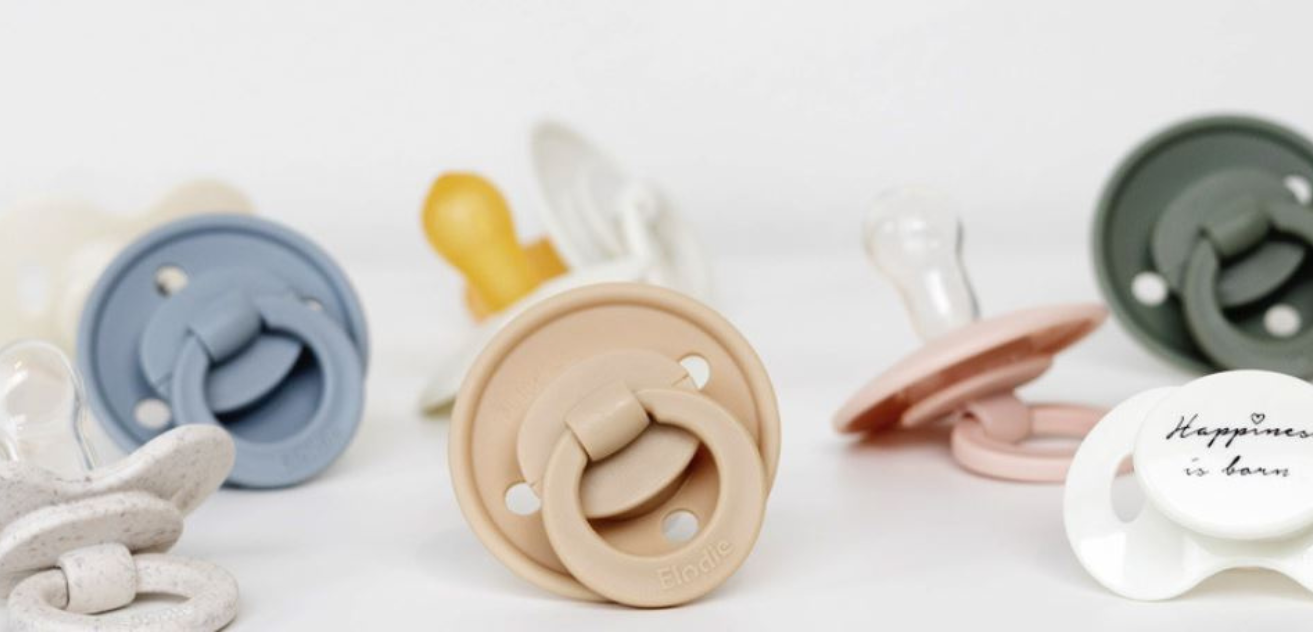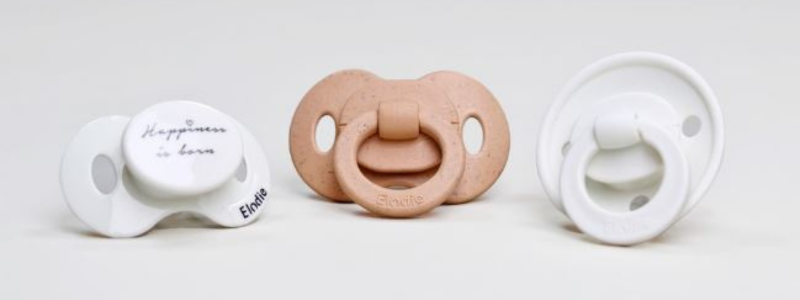
The ultimate guide to Elodie Pacifiers
One of the first products in Elodie's collections are pacifiers. The different styles and variants share an important characteristic: safety and high quality, always with an eye for style and trends. Today, the range is bigger than ever, with different materials, shapes, sizes and teats.
With all the variants available today, a new parent is bound to wonder: How do I choose the right pacifier for my baby?
In this guide, we will introduce you to some of the details and look at the different alternatives you will find in Elodie's range.

Three different styles
The classic pacifiers have a shield and button that are produced with a high-quality plastic called TRITAN™, which is extremely durable and robust. These pacifiers have been in Elodie's range for the longest time and have proven again and again that quality never goes out of style. Because both the shield and buttons can be printed, these pacifiers always match Elodie's pacifier clips and many of their other baby products. The shield of the classic pacifier is designed with ventilation holes that allow air to circulate around the mouth and help prevent skin irritation. The classic pacifier is designed with rounded and smooth edges that will never chafe sensitive cheeks.
Next, we have the Bamboo pacifiers - made from renewable, plant-based bamboo fibres. Elodie was the first brand in the world to develop a pacifier for families who want to make a more sustainable choice and reduce their environmental impact, one pacifier at a time. Double ventilation holes help reduce skin irritation and the ring makes it easy to handle for both child and parent.
Last but not least, we have the Binky Bundle, a duo pack of pacifiiers with a round retro-inspired design that is easy to fall in love with. The shield is slightly curved outwards and features three vents for air circulation. All designed to protect the sensitive skin around your baby's mouth from irritation. These are available in many carefully selected colours that perfectly match your other Elodie baby products, so you can create perfect style combinations for your little one.

Round or orthodontic teats?
Elodie offers both a symmetrical round teat and a more asymmetrical shape, called the orthodontic teat. The round teat is slightly longer and can be useful when first introducing pacifiers as they are more similar to the shape of a nipple. The orthodontic teats are great because they lie between the upper and lower jaw, which promotes healthy gum and jaw development, plus it allows for more tongue movement around the teat.
It may take some time to find the right teat shape, as every baby is different. Your first child might have preferred a round teat, but your second baby might prefer an orthodontic teat. To find the perfect pacifier for your baby, you will have to do some trial and error. For example, if you buy a round teat of the right size and he constantly spits it out, try an orthodontic one next time.

Silicone or Latex?
The most commonly used material for pacifiers is food-grade silicone. The main advantage of silicone is that it is strong and durable, easy to clean and long-lasting. The material does not age and does not retain odours.
The other alternative available is latex, also known as natural rubber. Latex is softer and more flexible than silicone. But these teats wear out faster and need to be replaced more often. If your child has a latex allergy, you should avoid these pacifiers.
As with the shape of the teat, the material can be a deciding factor in your baby accepting one and refusing another. If a silicone teat does not work, it is a good idea to see if your baby prefers the softer feel of a latex teat.

Finding the right size
The difference between pacifier sizes is the size of the teat and the shield. As a baby grows, his mouth gets bigger and he gets more used to sucking - the strength in his mouth and tongue increases. The most significant changes take place in the first few months, which is why Elodie offers pacifiers for newborns, with smaller shields and teats, and a larger version generally recommended from 3 months.
After the age of three months, there is no need to adjust the sizes, as the size your child is used to will also be the size they prefer until it is time to phase out pacifier use altogether. Some little ones will take longer to switch from the small to the larger size, but if you keep offering them the larger pacifier size they will eventually get used to it.
Related posts
How to choose the right sleeping bag
in 'Blogpost'
Tips for the 'perfect' afternoon nap!
in 'Blogpost'
In the picture: BeSafe Pregnant
in 'Blogpost'
